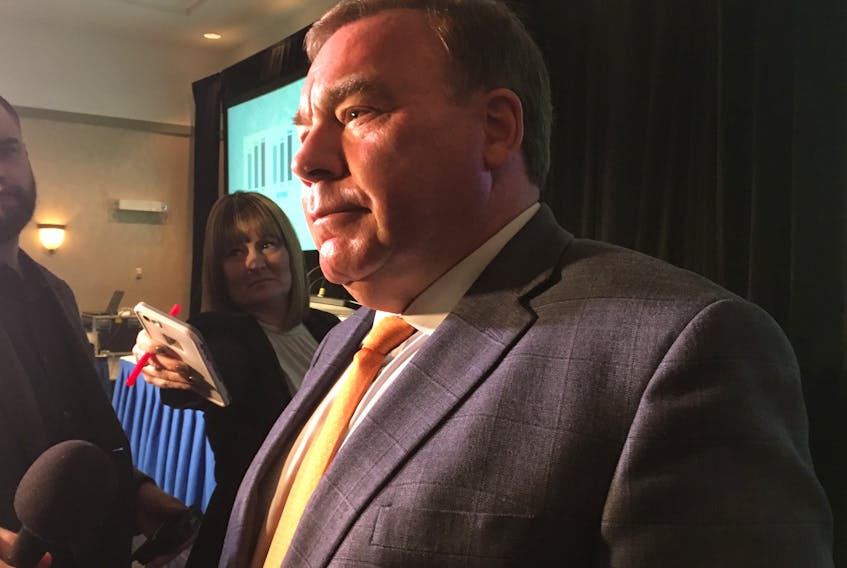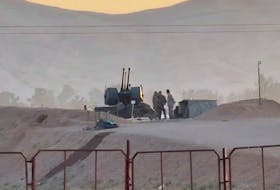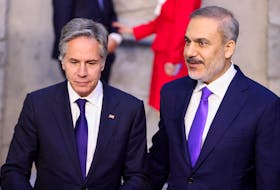Nalcor Energy president and CEO Stan Marshall says he’s holding firm on the estimated cost and schedule for the Muskrat Falls hydroelectric project, but there is a risk of new costs, extending from the ongoing public inquiry into the project.
Speaking with The Telegram on Tuesday, Marshall said Nalcor is maintaining its total cost estimate on the project of $12.7 billion — including capital, interest and financing costs — and a schedule for first power late this year.
That is not changing, despite a risk assessment by Westney Consulting now in hand suggesting there is $170 million to $370 million in risk — in potential for additional cost — not covered by the current project estimate. Risks named include additional protests, unforeseen government directives and the ongoing public inquiry (specifically being estimated at $45 million to $165 million in added risk).
Westney Consulting’s report warns external project investigations can cause loss of focus, loss of motivation, executive paralysis, slowed decision-making, and project team resignations and turnover. An excerpt from the Westney report was released to The Telegram by Nalcor Energy. The full report is being reviewed by the corporation’s legal team.
As reported by the CBC, the filing of Westney’s Quantitative Risk Assessment in 2018 was noted in a quarterly report of the Muskrat Falls Oversight Committee. The question now becomes to what extent identified risks could become reality.
"...it’s hard to quantify what the consequences might be. And you try to work with the inquiry, you try to work with the governments to minimize that. At the end of the day, who knows."
— Stan Marshall
The work to complete the project is one thing, Marshall said. He said solid progress is being made, while Nalcor Energy is also actively managing the additional demands of the provincial government and the public, including the inquiry and the new review of options for power rate mitigation, ongoing before the Public Utilities Board (PUB).
One of Marshall’s concerns is distraction.
Yet he was able to testify at the inquiry’s last round of public hearings, so how significant a concern could that practically be?
“I’m not so much worried about me, but I’ve got my key people,” he suggested, when challenged on the idea. “Like right now, we’ve got an arbitration with Astaldi, for example. And instead of the people concentrating on reviewing the materials on that, and their evidence and everything else, they could be thinking about the next phase of the inquiry.”
He said it’s hard to estimate what could happen, and what it could cost.
Another concern he noted was around disclosure and the release of information that would otherwise be kept confidential. These instances were limited in the inquiry’s first phase, but more are expected as the next phase gets underway, with its deep dive into project contracting, management and details of internal estimates versus bids and actual costs.
He said the work of the inquiry could affect the results of ongoing disputes with contractors, as contractors could refuse to settle cases, or pursue new claims. He compared it to playing poker at a game where you’re forced to always show your hand.

“Again, it’s hard to quantify what the consequences might be. And you try to work with the inquiry, you try to work with the governments to minimize that. At the end of the day, who knows,” he said.
Marshall said he can only identify associated risks, then follow on whatever direction is issued from the provincial government and from Commissioner Richard LeBlanc — who already issued his own notice to the government and the public on the same. In a session specifically on the issue of public disclosure, LeBlanc said he is assuming the provincial government has considered the fact the work of the inquiry is in the public eye.
In the meantime, Marshall said the Westney assessment is a probabilistic analysis to consider and not a hard number, with hundreds of variables involved in the risks identified. And he isn’t prepared to add to the public project estimate based on what’s in front of him and the ongoing work of the project team.
In terms of progress, he said the focus has been on the successful changeover from contractor Astaldi Canada to Pennecon Ltd. on the Muskrat Falls intake, powerhouse, spillway and transition dam. Astaldi was issued a stop-work order on Oct. 18 and notice of termination Nov. 8.
“GE and the software for the transmission lines is a big issue. But we’re working through them,” Marshall said.
The Labrador-Island Transmission Link, part of the power project, has been operating for a month and Marshall said it has been carrying 100 megawatts, sometimes more, power to the island.
Public hearings in the second phase of the Muskrat Falls inquiry are scheduled to begin Feb. 18 in Happy Valley-Goose Bay.
Twitter: @TeleFitz
RELATED STORIES:









